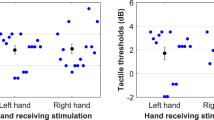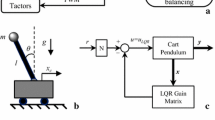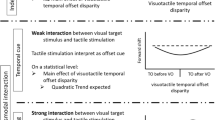Abstract
It is far more difficult to detect a small tactile stimulation on a finger that is moving compared to when it is static. This suppression of tactile information during motion, known as tactile gating, has been examined in some detail during single-joint movements. However, the existence and time course of this gating has yet to be examined during visually guided multi-joint reaches, where sensory feedback may be paramount. The current study demonstrated that neurologically intact humans are unable to detect a small vibratory stimulus on one of their index fingers during a bimanual reach toward visual targets. By parametrically altering the delay between the visual target onset and the vibration, it was demonstrated that this gating was even apparent before participants started moving. A follow up experiment using electromyography indicated that gating was likely to occur even before muscle activity had taken place. This unique demonstration of tactile gating during a task reliant on visual feedback supports the notion this phenomenon is due to a central command, rather than a masking of sensory signals by afferent processing during movement.





Similar content being viewed by others
References
Bays PM, Flanagan JR, Wolpert DM (2006) Attenuation of self-generated tactile sensations is predictive, not postdictive. PLoS Biol 4:e28
Buckingham G, Carey DP (2009) Rightward biases during bimanual reaching. Exp Brain Res 194:197–206
Cavanagh PR, Komi PV (1979) Electromechanical delay in human skeletal muscle under concentric and eccentric contractions. Eur J Appl Physiol 42:159–163
Chapman CE, Bushnell MC, Miron D, Duncan GH, Lund JP (1987) Sensory perception during movement in man. Exp Brain Res 68:516–524
Dijkerman HC, de Haan EHF (2007) Somatosensory processes subserving perception and action. Behav Brain Sci. 30:189–239
Flanagan JR, Beltzner MA (2000) Independence of perceptual and sensorimotor predictions in the size-weight illusion. Nat Neurosci 3:737–741
Flanagan JR, Bowman MC, Johansson RS (2006) Control strategies in object manipulation tasks. Exp Brain Res 16:1–10
Gescheider G (1997) Psychophysics: the fundamentals, 3rd edn. Lawrence Erlbaum Associates, NJ
Goodale MA, Milner AD (1992) Separate visual pathways for perception and action. Trends Neurosci 15:20–25
Goodale MA, Pellison D, Prablanc C (1986) Large adjustments in visually guided reaching do not depend on vision of the hand or perception of target displacement. Nature. 320:748–750
Gordon AM, Forssberg H, Johansson RS, Westling G (1991) Integration of sensory information during the programming of precision grip: comments on the contributions of size cues. Exp Brain Res 85:226–229
Guiard Y (1987) Asymmetric division of labour in human skilled bimanual action: the kinematic chain as a model. J Mot Behav 19:486–517
Hartcher-O’Brien J, Gallace A, Krings B, Koppen C, Spence C (2006) When vision ‘extinguishes’ touch in neurologically-normal people: extending the Colavita visual dominance effect. Exp Brain Res 186:643–658
Jiang W, Chapman CE, Lamarre Y (1990) Modulation of somatosensory evoked responses in the primary somatosensory cortex produced by intracortical microstimulation of the motor cortex in the monkey. Exp Brain Res 80:333–344
Klatzky RL, Lederman SL (2007) Do intention and exploration modulate the pathways to haptic object identification? Behav Brain Sci. 30:213–214
Nickerson RS (1974) Intersensory facilitation of reaction time. Psychol Rev 80:489–509
Ohtsuki T (1994) Change in strength, speed, and reaction time induced by simultaneous bilateral muscle activity. In: Swinnen SP, Heuer H, Massion J, Cesaer P (eds) Interlimb coordination: neural dynamical and cognitive constraints. Academic press, NY, pp 259–274
Rao AK, Gordon AM (2001) Contribution of tactile information to accuracy in pointing movements. Exp Brain Res 138:438–445
Viitasalo J, Komi P (1981) Interrelationships between electromyographic, mechanical, muscle structure and reflex time measurements in man. Acta Physiol Scand 111:97–103
Voss M, Ingram JN, Haggard P, Wolpert DM (2006) Sensorimotor attenuation by central motor command signals in the absence of movement. Nat Neurosci 19:26–27
Voss M, Ingram JN, Wolpert DM, Haggard P (2008) Mere expectation to move causes attenuation of sensory signals. PLoS ONE 3:e2866. doi:10.1371/journal.pone.0002866
Walsh E, Haggard P (2007) The internal structure of stopping revealed by a sensory detection task. Exp Brain Res 183:405–410
Williams SR, Chapman CE (2002) Time course and magnitude of movement-related gating of tactile detection in humans III. Effect of motor tasks. J Neurophysiol 88:1968–1979
Williams SR, Shenasa J, Chapman CE (1998) Time course and magnitude of movement-related gating of tactile detection in humans. I. Importance of stimulus location. J Neurophysiol 79:947–963
Wolpert DM, Flanagan JR (2001) Motor prediction. Curr Biol 18:R729–R732
Acknowledgments
The authors would like to thank Dr. Matt Heath for his thought-provoking discussions on this topic. This work was supported by a 6th Century Ph.D. studentship from the College of Life Sciences and Medicine at the University of Aberdeen, and a postdoctoral research fellowship from the Department of Foreign Affairs and International Trade (DFAIT) Canada, awarded to G Buckingham. G Binsted was funded by Natural Sciences and Engineering Research Council of Canada (NSERC).
Author information
Authors and Affiliations
Corresponding author
Electronic supplementary material
Below is the link to the electronic supplementary material.
Rights and permissions
About this article
Cite this article
Buckingham, G., Carey, D.P., Colino, F.L. et al. Gating of vibrotactile detection during visually guided bimanual reaches. Exp Brain Res 201, 411–419 (2010). https://doi.org/10.1007/s00221-009-2050-8
Received:
Accepted:
Published:
Issue Date:
DOI: https://doi.org/10.1007/s00221-009-2050-8




